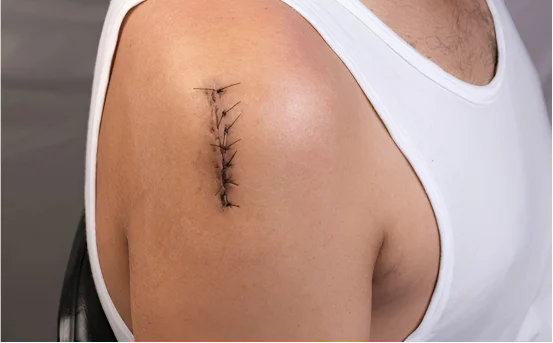Rotator cuff injury is one of the leading causes of shoulder pain, particularly among older adults, athletes, and workers. Rotator cuff surgery is a good option when non-surgical treatment options like physical therapy or medication fail to alleviate symptoms. There is no “one-size-fits all” approach. Rotator cuff surgery can be tailored to fit the severity and nature of the injury. Understanding of types of rotator cuff repair surgery/
What is Rotator Cuff Repair?
The rotator-cuff is made up of four muscles and tendon that work together to stabilize the shoulder and provide smooth movement. Acute trauma, repetitive movements, and degenerative changes can cause injuries. The goal of rotator cuff surgery is to repair torn tendons and restore shoulder function and strength.
Rotator Cuff Injuries:
- Shoulder pain that persists (especially when raising the arm).
- Weakness of the shoulder
- Clicking or popping noises during movement
- Limitation of range of motion
Why Rotator Cuff Surgery is Required
Understanding the different types of rotator cuff repair surgery can help patients make informed decisions regarding their treatment options.
When is surgery recommended?
- The tear is complete or large
- Pain persists despite non-surgical treatments
- Weakness can have a significant impact on daily activities
- The patient is active or young
- The tear gets worse over time
Early intervention can improve long-term outcomes by preventing muscle atrophy and stiffness of joints.
There are many types of rotator cuff repair surgery
Your orthopedic surgeon will recommend one of these surgical techniques depending on the type and severity of the tear.
1. Arthroscopic Rotator Sleeve Repair
The procedure is minimally invasive. Fast recovery.
This technique involves inserting a small camera, called an arthroscope, through tiny incisions. The camera is used to view the torn tendons. The tendon is then reattached to the bone using specialized instruments.
Ideal for: Small to medium sized tears
Advantages:
- Incisions made smaller
- Scarring is reduced
- Blood loss is reduced
- Faster recovery
Disadvantages:
- The best way to deal with massive tears
- The surgeon’s job is technically demanding
2. Mini-Open Rotator Repair
Combination of traditional and arthroscopic methods.
Procedure: Starts with arthroscopy to assess damage and treat it, then moves to a small incision for the tendon repair.
Best for: Medium to Large Tears
Advantages:
- Access to the tendon is easier
- Repairs complex tears
Disadvantages:
- Recovery time is slightly longer than with full arthroscopy
- Post-operative pain is more severe with arthroscopic surgery
3. Open Rotator Cuff Replacement
Traditional surgery is used for large or complicated tears.
Procedure: A larger incision is made to separate and reconnect the deltoid muscles to allow full access to the torn wrist cuff. The tendon will then be stitched to the bone.
Ideal for: Large, severe or chronic tears.
Advantages:
- The ideal solution for complex or retracted tears
- Tested and proven results
Disadvantages:
- More soft tissue damage and larger incision
- Recovery time is longer and scarring is more severe
- Post-operative discomfort
4. Tendon Transfer Surgery
If the original tendon cannot be repaired.
Procedure: The torn tendon is replaced with a nearby tendon, usually from the pectoralis or latissimus major.
The best choice for: Rotator cuff tears that are irreparable or have been retracted.
Advantages:
- Restore shoulder function if direct repair is not possible
Disadvantages:
- Technically challenging
- Longer Rehabilitation
5. Superior Capsular Repair (SCR)
A new option for large irreparable tears.
Procedure: A graft is placed (from the patient’s or a donor’s tissue) between the socket and the shoulder bone to stabilize it and restore its function.
Best for: Rotator cuff tears that are irreparable and do not have arthritis.
Advantages:
- Avoid shoulder replacement with this product
- It can improve range of movement and reduce pain
Disadvantages:
- Newer procedure; long-term results still under study
- Some cases may not be suitable for all
What to expect after Surgery
Recovery Time
- Arthroscopic Surgery: 3 to 6 months
- Open or Mini-open surgery: 4-9 Months
- Tendon Transfer or SCR: 6-12 Months
Rehabilitation includes:
- Use of a sling for 4-6 weeks
- Physical therapy begins 1-2 weeks following surgery.
- Return to normal daily activities
To regain shoulder flexibility and strength, it is important to be consistent with your rehab exercises.
Risks and Complications
There are risks associated with all surgeries.
- Infection
- Shoulder stiffness or freezing
- Nerve damage
- Re-tear the tendon
- Delayed healing
These risks can be greatly reduced by choosing a highly-skilled orthopedic surgeon and adhering to post-op instructions.
Conclusion
It is important to choose the correct type of rotator cuff repair surgery for a long-lasting shoulder function and a successful recovery. Each technique has different indications, risks, and benefits. The decision is usually made based on factors such as the size of a tear, the quality of the tissue, the patient’s age, level and type activity, and their overall health.
Consult a qualified orthopedist if you suspect that your rotator-cuff is injured or if you are considering surgery. You can recover your shoulder strength with the right diagnosis and treatment.























